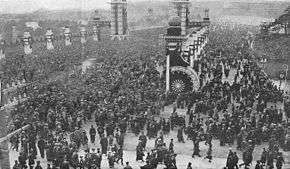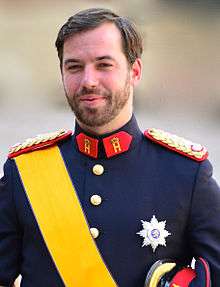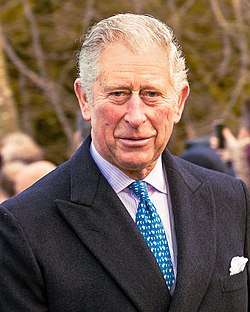Heir apparent
An heir apparent[note 1] is a person who is first in an order of succession and cannot be displaced from inheriting by the birth of another person. An heir presumptive, by contrast, is someone who is first in line to inherit a title but who can be displaced by the birth of a more eligible heir.
| Part of a series of articles on |
| Monarchy |
|---|
.svg.png) |
|
Central concepts |
|
History
|
| Politics portal |
Today these terms most commonly describe heirs to hereditary titles (e.g. titles of nobility) or offices, especially when only inheritable by a single person. Most monarchies refer to the heir apparent of their thrones with the descriptive term of crown prince or crown princess, but they may also be accorded with a more specific substantive title:[note 2] such as Prince of Orange in the Netherlands, Duke of Brabant in Belgium, Prince of Asturias in Spain (also granted to heirs presumptive), or Prince of Wales in the United Kingdom (former titles include le Dauphin during the Kingdom of France and Tsesarevich in Imperial Russia).
The term is also used metaphorically to indicate an "anointed" successor to any position of power, e.g. a political or corporate leader.
This article primarily describes the term heir apparent in a hereditary system regulated by laws of primogeniture—it may be less applicable to cases where a monarch has a say in naming the heir (performed either while alive, e.g. crowning the heir as a rex iunior, or through the monarch's will).
Heir apparent vs. heir presumptive

In a hereditary system governed by some form of primogeniture, an heir apparent is easily identifiable as the person whose position as first in the line of succession to a title or office is secure, regardless of future births. An heir presumptive, by contrast, can always be "bumped down" in the succession by the birth of somebody more closely related in a legal sense (according to that form of primogeniture) to the current title-holder.
The clearest example occurs in the case of a childless bearer of a hereditary title that can only be inherited by one person. If at any time the title bearer were to produce children, those children would rank ahead of any person who had formerly been heir presumptive.
Many legal systems assume childbirth is always possible regardless of age or health. In such circumstances a person may be, in a practical sense, the heir apparent but still, legally speaking, heir presumptive. Indeed, when Queen Victoria succeeded her uncle King William IV, the wording of the proclamation even gave as a caveat:
...saving the rights of any issue of his late Majesty King William IV, which may be born of his late Majesty's consort.
This provided for the possibility that William's wife, Adelaide of Saxe-Meiningen, was pregnant at the moment of his death, since such a posthumous child, regardless of its sex, would have displaced Victoria from the throne.[1] Adelaide was 44 at the time, so pregnancy was possible even if unlikely.
Daughters in male-preference primogeniture
Daughters (and their lines) may inherit titles that descend according to male-preference primogeniture, but only in default of sons (and their heirs). That is, both female and male offspring have the right to a place somewhere in the order of succession, but when it comes to what that place is, a female will rank behind her brothers regardless of their ages or her age.
Thus, normally, even an only daughter will not be heir apparent, since at any time a brother might be born who, though younger, would assume that position. Hence, she is an heir presumptive. For example, Queen Elizabeth II was heir presumptive during the reign of her father, King George VI, because at any stage up to his death, George could have fathered a legitimate son.
Women as heirs apparent
In a system of absolute primogeniture that disregards gender, female heirs apparent occur. As succession to titles, positions, or offices in the past most often favoured males, females considered to be an heir apparent were rare. Absolute primogeniture was not practised by any modern monarchy for succession to their thrones until the late twentieth century, with Sweden being the first to adopt absolute primogeniture in 1980 and other Western European monarchies following suit.
Since the adoption of absolute primogeniture by contemporary Western European monarchies, examples of female heirs apparent include: Crown Princess Victoria of Sweden, Princess Catharina-Amalia of the Netherlands, and Princess Elisabeth of Belgium; they are, respectively, the oldest children of Kings Carl XVI Gustaf, Willem-Alexander, and Philippe. Princess Ingrid Alexandra of Norway is heir apparent to her father, who is heir apparent to the Norwegian throne, and Victoria herself has a female heir apparent in her oldest child, Princess Estelle. Victoria was not heir apparent from birth (in 1977), but gained the status in 1980 following a change in the Swedish Act of Succession. Her younger brother Carl Philip (born 1979) was thus heir apparent for a few months (and is a rare example of an heir apparent losing this status without a death occurring).
In 2015, pursuant to the 2011 Perth Agreement, the Commonwealth realms changed the rules of succession to the 16 thrones of Elizabeth II to absolute primogeniture, except for male heirs born before the Perth Agreement. The effects are not likely to be felt for many years; the first two heirs at the time of the agreement (Charles, Prince of Wales, and his son Prince William, Duke of Cambridge) were already eldest born children, and in 2013 William's first-born son Prince George of Cambridge became the next apparent successor.
But even in legal systems that apply male-preference primogeniture, female heirs apparent are by no means impossible: if a male heir apparent dies leaving no sons but at least one daughter, then the eldest daughter would replace her father as heir apparent to whatever throne or title is concerned, but only when it has become clear that the widow of the deceased is not pregnant. Then, as the representative of her father's line she would assume a place ahead of any more distant relatives. Such a situation has not to date occurred with the English or British throne; several times an heir apparent has died, but each example has either been childless or left a son or sons. However, there have been several female heirs apparent to British peerages (e.g. Frances Ward, 6th Baroness Dudley, and Henrietta Wentworth, 6th Baroness Wentworth).
In one special case, however, England and Scotland had a female heir apparent. The Revolution settlement that established William and Mary as joint monarchs in 1689 only gave the power to continue the succession through issue to Mary II, eldest daughter of the previous king, James II. William, by contrast, was to reign for life only, and his (hypothetical) children by a wife other than Mary would be placed in his original place (as Mary's first cousin) in the line of succession – after Mary's younger sister Anne. Thus, although after Mary's death William continued to reign, he had no power to beget direct heirs,[2] and Anne became the heir apparent for the remainder of William's reign. She eventually succeeded him as Queen of England, Scotland and Ireland.
Displacement of heirs apparent
The position of an heir apparent is normally unshakable: it can be assumed they will inherit. Sometimes, however, extraordinary events—such as the death or the deposition of the parent—intervene.
People who lost heir apparent status
- Parliament deposed James Francis Edward Stuart, the infant son of King James II & VII (of England and Scotland respectively) whom James II was raising as a Catholic, as the King's legal heir apparent—declaring that James had, de facto, abdicated—and offered the throne to James II's oldest daughter, the young prince's much older Protestant half-sister, Mary (along with her husband, Prince William of Orange). When the exiled King James died in 1701, his Jacobite supporters proclaimed the exiled Prince James Francis Edward as King James III of England and James VIII of Scotland; but neither he nor his descendants were ever successful in their bids for the throne.
- Crown Prince Gustav (later known as Gustav, Prince of Vasa), son of Gustav IV Adolf of Sweden, lost his place when his father was deposed and replaced by Gustav IV Adolf's aged uncle, the Duke Carl, who became Charles XIII of Sweden in 1809. The aged King Charles XIII did not have surviving sons, and Prince Gustav was the only living male of the whole dynasty (besides his deposed father), but the prince was never regarded as heir of Charles XIII, although there were factions in the Riksdag and elsewhere in Sweden who desired to preserve him, and, in the subsequent constitutional elections, supported his election as his grand-uncle's successor. Instead, the government proceeded to have a new crown prince elected (which was the proper constitutional action, if no male heir was left in the dynasty), and the Riksdag elected first August, Prince of Augustenborg, and then, after August's death, the Prince of Ponte Corvo (Marshal Jean-Baptiste Bernadotte, who acceded as Charles XIV John in 1818). The two lines united later, when Charles XIV John's great-grandson Crown Prince Gustaf (who acceded as Gustaf V in 1907) married Gustav IV Adolf's great-granddaughter Victoria of Baden, who became Crown Princess of Sweden. Thus, from Gustav VI Adolf onwards, the kings of Sweden are direct descendants of both Gustav IV Adolf and his son's replacement as crown prince, Charles XIV John.
- Prince Carl Philip of Sweden, at his birth in 1979, was heir apparent to the throne of Sweden. Less than eight months later, a change in that country's succession laws instituted absolute primogeniture, and Carl Philip was supplanted as heir apparent by his elder sister Victoria.
- Muqrin bin Abdulaziz became Crown Prince of Saudi Arabia in January 2015 upon the death of his half-brother King Abdullah bin Abdulaziz Al Saud and the accession of another half-brother, Salman bin Abdulaziz Al Saud, to the Saudi throne. In April of that year, Salman removed Muqrin as Crown Prince, replacing him with their nephew Muhammad bin Nayef. Muhammad bin Nayef himself was later replaced as Crown Prince by the king's son Mohammad bin Salman.
Breaching legal qualification of heirs apparent
In some jurisdictions, an heir apparent can automatically lose that status by breaching certain constitutional rules. Today, for example:
- A British heir apparent would lose this status if he or she became a Catholic. This is the only religion-based restriction on the heir-apparent. (Previously, marrying a Catholic also equated to losing this status, however, in October 2011, the governments of the 16 Commonwealth realms —of which Queen Elizabeth II is monarch— agreed to remove the restriction on marriage to a Catholic. All of the Commonwealth realms subsequently passed legislation to implement the change, which fully took effect in March 2015.)
- Swedish Crown Princes and Crown Princesses would lose heir apparent status, according to the Act of Succession, if they married without approval of the monarch and the Government, abandoned the "pure Evangelical faith", or accepted another throne without the approval of the Riksdag.
- Dutch Princes and Princesses of Orange would lose status as heir to the throne if they married without the approval of the States-General, or simply renounced the right.
- Spanish Princes and Princesses of Asturias would lose status if they married against the express prohibition of the monarch and the Cortes.
- Belgian Dukes and Duchesses of Brabant would lose heir apparent status if they married without the consent of the monarch, or became monarch of another country.
- Danish Crown Princes and Princesses would lose status if they married without the permission of the monarch. When the monarch grants permission for a dynast to enter marriage, he may set conditions that must be met for the dynasts and/or their children to gain or maintain a place in the line of succession; this also applies for Crown Princes and Princesses.
Current heirs apparent
| Country | Picture | Name of Heir apparent | Title | Date of Birth (age) | Relation to Monarch |
|---|---|---|---|---|---|
 |
Salman bin Hamad bin Isa Al Khalifa | Crown Prince of Bahrain, Deputy King |
August 31, 1985 | eldest son | |
 |
Elisabeth | Princess, Duchess of Brabant |
October 25, 2001 | eldest child | |
.jpg) |
Jigme Namgyel Wangchuck | Dragon Prince of Bhutan, Druk Gyalsey of Bhutan |
February 5, 2016 | eldest child | |
 |
Al-Muhtadee Billah | Crown Prince of Brunei Darussalam | February 17, 1974 | eldest son | |
 |
Frederik | Crown Prince of Denmark, Count of Monpezat |
May 26, 1968 | eldest child | |
 |
Hamdan bin Mohammed bin Rashid al Maktoum | Sheikh, Crown Prince of Dubai |
November 14, 1982 | second son | |
 |
Hussein bin Abdullah | Crown Prince of Jordan | June 28, 1994 | eldest son | |
.jpg) |
Nawaf Al-Ahmad Al-Jaber Al-Sabah | Sheikh, Crown prince of Kuwait |
June 25, 1937 | younger half-brother | |
 |
Lerotholi Seeiso | Crown Prince of Lesotho | April 18, 2007 | only son | |
 |
Alois | Hereditary Prince of Liechtenstein | June 11, 1968 | eldest son | |
 |
Guillaume | Hereditary Grand Duke of Luxembourg | November 11, 1981 | eldest child | |
 |
Jacques | Hereditary Prince of Monaco, Marquis of Baux | December 10, 2014 | only legitimate son | |
 |
Moulay Hassan | Crown Prince of Morocco | May 8, 2003 | only son | |
.jpg) |
Catharina-Amalia | Princess of Orange | December 7, 2003 | eldest child | |
 |
Haakon Magnus | Crown Prince of Norway | July 20, 1973 | only son | |
 |
Mohammad bin Salman bin Abdulaziz Al Saud | Crown Prince of Saudi Arabia | August 31, 1985 | child | |
 |
Victoria | Crown Princess of Sweden, Duchess of Västergötland |
July 14, 1977 | eldest child | |
 |
Tupoutoʻa ʻUlukalala | Crown Prince of Tonga | September 17, 1985 | eldest son | |
and 15 other Commonwealth realms |
 |
Charles | Prince of Wales, Duke of Cornwall, Duke of Rothesay |
November 14, 1948 | eldest son |
Heirs apparent who never inherited the throne
Heirs apparent who predeceased the monarch
Heirs apparent who were forced to abandon their claim
| Heir apparent | Lived | Heir of | Forced out |
|---|---|---|---|
| Crown Prince Mian | Died 707 BC | Duke Huan of Chen | Killed by uncle Chen Tuo |
| Fusu | Died 210 BC | Qin Shihuang | Forced to commit suicide |
| Liu Rong | Died 148 BC | Emperor Jing of Han | His mother angered the emperor by requesting the position of empress and denying the marriage of Chen Jiao and him |
| Kunala | Born 263 BC | Ashoka | Blinded |
| Agrippa Postumus | BC 12–14 AD | Augustus | Banished |
| Yuan Xun | 483-497 | Emperor Xiaowen of Northern Wei | Disagreement of his father’s policy |
| Niketas the Persian | Died 636 | Shahrbaraz | Killed after 40 days of rule |
| Yang Yong | Died 604 | Emperor Wen of Sui | Forced to abdicate and killed by younger brother Yang Guang |
| Li Chengqian | 619-645 | Emperor Taizong of Tang | Exiled from immorality and treason |
| Li Zhong | 642-665 | Emperor Gaozong of Tang | Empress Wu Zetian got the favor from Gaozong and his position was taken by his half brother Li Hong |
| Li Xian | 655-684 | Exiled by Empress Wu Zetian from rumors. And forced to commit suicide after Gaozong’s death | |
| Prince Kusakabe | 662–689 | Emperor Tenmu | Did not assume throne |
| Li Chengqi | 679-742 | Emperor Ruizong of Tang | Gave up the claim because he thought that he did not have the strength to be a wise emperor |
| Alexios Mosele | 9th century | Theophilos | Disinherited for rebellion |
| Al-Abbas ibn Ahmad ibn Tulun | Died 884 | Ahmad ibn Tulun | Attempted to overthrow his father |
| Li Yu | Died in 904 | Emperor Zhaozong of Tang | Actually inherited the throne in fact, but not recognized as an emperor. Became crown prince again after two months and killed by Zhu Wen |
| Prince Atsuyasu | 999-1019 | Emperor Ichijō | Kugyō Fujiwara no Yukinari and Fujiwara no Michinaga forced him to give up the status and his half brother Prince Atsuhira took his position. |
| Al-Malik al-Aziz | Died 1049 | Jalal al-Dawla | Late ruler's nephew took the throne instead |
| Conrad II of Italy | 1074–1101 | Henry IV, Holy Roman Emperor | Disinherited for rebellion |
| Min Shin Saw | 1117–1167 | Alaungsithu | Exiled |
| William I, Count of Boulogne | 1137–1159 | Stephen, King of England | Treaty of Wallingford |
| Demna of Georgia | 1155–1178 | David V of Georgia | Imprisoned, blinded and castrated by his uncle, King George III of Georgia |
| Zhao Hong | Died 1225 | Emperor Ningzong | Shi Miyuan and Empress Yang faked the edict of emperor. |
| Henry (VII) of Germany | 1211–1242 | Frederick II, Holy Roman Emperor | Disinherited for rebellion |
| James of Majorca | 1275–1330 | James II of Majorca | Became a monk |
| James of Aragon | 1296–1334 | James II of Aragon | Became a monk |
| Otto, Duke of Lolland and Estonia | 1310–1346 | Christopher II of Denmark | Forced to surrender claim to the throne |
| Eric XII of Sweden | 1339–1359 | Magnus VII of Norway | Became King of Sweden |
| Baw Ngan-Mohn | 1370–1390 | Binnya U | Imprisoned |
| Zhu Wenkui | Disappeared in 1402 | Jianwen Emperor | Prince Yan sacked Nanjing. Disappeared with his father Jianwen Emperor. |
| Dmitry Ivanovich | 1483–1509 | Ivan III of Russia | Disinherited in favor of uncle Vasili III of Russia |
| Carlos, Prince of Asturias | 1545–1568 | Philip II of Spain | Arrested and imprisoned by his father; died in prison six months later |
| Minye Kyawswa II of Ava | 1567–1599 | Nanda Bayin | Defected |
| Yinreng | 1674–1725 | The Kangxi Emperor | Imprisoned for life by Kangxi for immorality and treason |
| Alexei Petrovich, Tsarevich of Russia | 1690–1718 | Peter the Great of Russia | Imprisoned by his father and forced to relinquish his claim. Died in prison |
| Crown Prince Sado of Joseon (Korea) | 1735–1762 | Yeongjo of Joseon (Korea) | His father killed him by locking him in a rice chest |
| Philip, Duke of Calabria | 1747–1777 | Charles III of Spain | Intellectually disabled; removed from the line of succession |
| Pedro, Prince Imperial of Brazil | 1825–1891 | Pedro IV of Portugal | Became heir solely to Brazil |
| Mustafa Fazıl Pasha | 1830–1875 | Isma'il Pasha | Succession law changed to pass from father to son instead of brother to brother |
| Tengku Alam Shah | 1846–1891 | Sultan Ali of Johor | Throne given to kinsman instead |
| George, Crown Prince of Serbia | 1887–1972 | Peter I of Serbia | Abdicated his succession rights in 1909 |
| Mohammad of Saudi Arabia | 1910–1988 | King Faisal ibn Abdul-Aziz | Forced to abdicate in 1965 |
| Tunku Abdul Rahman of Johor | 1933–1989 | Ismail of Johor | His elder brother Iskandar of Johor was reinstated after previously being forced to renounce his rights |
| Muqrin of Saudi Arabia | 1945– | King Salman bin Abdulaziz Al Saud | Removed as Crown Prince in April 2015; replaced by his nephew Muhammad bin Nayef |
| Hassan of Jordan | 1947– | King Hussein of Jordan | He was replaced by his nephew Abdullah only days before the king died in 1999 |
| Muhammad bin Nayef of Saudi Arabia | 1959– | King Salman bin Abdulaziz Al Saud | Removed as Crown Prince in June 2017; replaced by his cousin Mohammad bin Salman |
| Mishaal bin Hamad bin Khalifa Al Thani | 1972– | Hamad bin Khalifa Al Thani | Renounced his claim in 1996 in favor of his younger half-brother, Sheikh Jasim |
| Jasim bin Hamad bin Khalifa Al Thani | 1978– | Hamad bin Khalifa Al Thani | Renounced his claim in 2003 in favor of his younger brother, Sheikh Tamim |
| Prince Carl Philip of Sweden | 1979– | Carl XVI Gustaf of Sweden | Swedish succession laws were changed in 1980. Carl Philip was supplanted by his elder sister Victoria |
| Prince Hamzah of Jordan | 1980– | Abdullah II of Jordan | Title of Crown Prince removed in 2004. Hamzah was supplanted by his half-nephew Hussein |
Heirs apparent of monarchs who themselves abdicated or were deposed
| Heir apparent | Lived | Heir of | End of line/monarchy |
|---|---|---|---|
| Lucius Calpurnius Piso Licinianus | 38–69 | Galba | Assassinated in 69 |
| Gaius Julius Verus Maximus | 217–238 | Maximinus Thrax | Assassinated in 238 |
| Publius Licinius Egnatius Marinianus | 249-268 | Gallienus | Killed in 268 |
| Chen Yin | 573-618 | Chen Shubao | Chen Dynasty fell |
| Meng Xuanzhe | 937-991 | Meng Chang | Later Shu was defeated by Song Dynasty |
| William fitz Duncan | 1090–1147 | Duncan II of Scotland | Duncan II was killed in battle in 1094 |
| Edward Balliol | 1283–1367 | John Balliol | Abdicated following defeat in First War of Scottish Independence |
| John of Denmark | 1518–1532 | Christian II of Denmark | Christian II was deposed in 1523 |
| Gustav of Sweden | 1568–1607 | Eric XIV of Sweden | Eric XIV was deposed in 1568 |
| Zhu Cilang | 1629-1644 | Chongzhen Emperor | Ming conquered by Manchu and founded Qing Dynasty |
| James Francis Edward Stuart | 1688–1766 | James II of England | James II was deposed 11 April 1689 for being Catholic |
| Prince David of Georgia | 1767–1819 | George XII of Georgia | Annexation by Russia |
| Louis-Antoine, Dauphin and Duke of Angoulême | 1775–1844 | Charles X of France | Abdicated jointly with his father on 2 August 1830 |
| Louis-Charles, Dauphin of France | 1785–1795 | Louis XVI of France | French Revolution |
| Prince Constantine of Imereti | 1789–1844 | Solomon II of Imereti | Annexation by Russia |
| Gustav, Prince of Vasa | 1799–1877 | Gustav IV Adolf of Sweden | Gustav's whole family was excluded from the line of royal succession on 10 May 1809 by the Riksdag of the Estates, after the deposition of Gustav IV Adolf. |
| Agustín Jerónimo de Iturbide y Huarte | 1807–1866 | Agustín I of Mexico | Deposed in 1823 |
| Prince Philippe, Count of Paris | 1838–1894 | Louis Philippe I of France | Declaration of the Second Republic on 24 February 1848 |
| Ernest Augustus, Crown Prince of Hanover | 1845–1923 | George V of Hanover | Annexation by Prussia |
| Ernest, Landgrave of Hesse-Philippsthal | 1846–1925 | Charles II, Landgrave of Hesse-Philippsthal | Annexation by Prussia |
| William, Hereditary Prince of Nassau | 1852–1912 | Adolphe, Duke of Nassau | Annexation by Prussia |
| Louis Napoléon, Prince Imperial | 1856–1879 | Napoleon III of France | Napoleon III was deposed 4 September 1870 by the forces of the Third Republic |
| Crown Prince Gustaf of Norway | 1858–1950 | Oscar II of Norway | Dissolution of the union between Norway and Sweden |
| Agustín de Iturbide y Green | 1863–1925 | Maximilian I of Mexico | Maximilian executed in 1867 |
| Abdulmejid II | 1868–1944 | Mehmed VI | Ottoman Empire dissolved in 1922. |
| Prince Emanuele Filiberto, Duke of Aosta | 1869–1931 | Amadeo I of Spain | Abdicated in 1873 |
| Rupprecht, Crown Prince of Bavaria | 1869–1955 | Ludwig III of Bavaria | German monarchies abolished in November 1918 |
| Danilo, Crown Prince of Montenegro | 1871–1939 | Nikola I Petrović-Njegoš | Annexed by Serbia |
| Kaʻiulani | 1875–1899 | Liliuokalani | Annexation by the United States |
| Yuan Keding | 1878–1958 | Yuan Shikai | Short lived Empire abolished in March 1916 |
| Wilhelm, German Crown Prince | 1882–1951 | Wilhelm II, German Emperor | Wilhelm was deposed by the German government on 9 November 1918 |
| Georg, Crown Prince of Saxony | 1893–1943 | Frederick Augustus III of Saxony | German monarchies abolished in November 1918 |
| Husain Bey, Crown Prince of Tunisia | 1893–1969 | Muhammad VIII al-Amin | Deposed in 1957 |
| Heinrich XLV, Hereditary Prince Reuss Younger Line | 1895–1945 | Heinrich XXVII, Prince Reuss Younger Line | German monarchies abolished in November 1918 |
| Josias, Hereditary Prince of Waldeck and Pyrmont | 1896–1967 | Friedrich, Prince of Waldeck and Pyrmont | German monarchies abolished in November 1918 |
| Philipp, Landgrave of Hesse | 1896–1980 | Prince Frederick Charles of Hesse, King-elect of Finland | Monarchy abolished in 1918 |
| Prince Wilhelm of Urach | 1897–1957 | Mindaugas II of Lithuania | Monarchy abolished in 1918 |
| Nikolaus, Hereditary Grand Duke of Oldenburg | 1897–1970 | Frederick Augustus II, Grand Duke of Oldenburg | German monarchies abolished in November 1918 |
| Muhammad Abdel Moneim | 1899–1979 | Abbas II of Egypt | Abbas II was deposed by the British for supporting the Ottomans in World War I |
| Georg Moritz, Hereditary Prince of Saxe-Altenburg | 1900–1991 | Ernst II, Duke of Saxe-Altenburg | German monarchies abolished in November 1918 |
| Alexei Nikolaevich, Tsarevich of Russia | 1904–1918 | Nicholas II of Russia | Nicholas abdicated on 2/15 March 1917 on behalf of both himself and his son. The monarchy was abolished 1 September 1917 |
| Georg Donatus, Hereditary Grand Duke of Hesse | 1906–1937 | Ernest Louis, Grand Duke of Hesse | German monarchies abolished in November 1918 |
| Johann Leopold, Hereditary Prince of Saxe-Coburg and Gotha | 1906–1972 | Charles Edward, Duke of Saxe-Coburg and Gotha | German monarchies abolished November 1918 |
| Alfonso, Prince of Asturias | 1907–1938 | Alfonso XIII of Spain | Alfonso XIII was deposed by the formation of the Second Spanish Republic on April 14, 1931. Prince Alfonso renounced his claim on 21 June 1933 so he could marry a commoner |
| Friedrich Franz, Hereditary Grand Duke of Mecklenburg-Schwerin | 1910–2001 | Frederick Francis IV, Grand Duke of Mecklenburg-Schwerin | German monarchies abolished in November 1918 |
| Ghazi bin Faisal | 1912–1939 | Faisal I of Syria | Deposed in 1920 |
| Charles Augustus, Hereditary Grand Duke of Saxe-Weimar-Eisenach | 1912–1988 | William Ernest, Grand Duke of Saxe-Weimar-Eisenach | German monarchies abolished November 1918 |
| Otto von Habsburg, Crown Prince of Austria, Hungary, Croatia and Bohemia | 1912–2011 | Charles I of Austria | Austria and Hungary abolished the monarchy in 1918. |
| 'Abd al-Ilah | 1913–1958 | Ali of Hejaz | Deposed in 1925 |
| Carol Victor, Hereditary Prince of Albania | 1913–1973 | Wied, Prince of Albania | Fled into exile in 1914 |
| Prince Ernest Augustus of Hanover | 1914–1987 | Ernest Augustus, Duke of Brunswick | German monarchies abolished in November 1918 |
| Amha Selassie | 1916–1997 | Haile Selassie of Ethiopia | Haile Selassie was overthrown in 1974 after being taken by communist Derg power |
| Hasan as-Senussi | 1928–1992 | Idris of Libya | Deposed in 1969 |
| Vong Savang | 1931–1978 | Sisavang Vatthana | Monarchy abolished after Laotian Civil War |
| Ahmad Shah Khan, Crown Prince of Afghanistan | 1934– | Mohammed Zahir Shah | Deposed in 1973 |
| Bảo Long | 1936–2007 | Bảo Đại | 1955 State of Vietnam referendum |
| Vittorio Emanuele, Prince of Naples | 1937– | Umberto II of Italy | Italy abolished the monarchy on 12 June 1946, after Umberto II had reigned 33 days |
| Leka, Crown Prince of Albania | 1939–2011 | Zog of Albania | Two days after Leka's birth, Mussolini's Italy invaded Albania on 7 April 1939 and sent the royal family into exile |
| Crown Prince Amedeo of Savoy, Duke of Aosta | 1943– | Tomislav II of Croatia | Tomislav II abdicated October 12, 1943 due to the Armistice between Italy and Allied armed forces, when Amedeo was only two weeks old |
| Alexander, Crown Prince of Yugoslavia | 1945– | Peter II of Yugoslavia | Peter II was deposed by Yugoslavia's Constituent Assembly on 29 November 1945 |
| Abdelaziz bin Ahmed Al Thani | 1946–2008 | Ahmad bin Ali Al Thani | Deposed in 1972 |
| Reza Pahlavi, Crown Prince of Iran | 1960– | Mohammad Reza Pahlavi | The Shah was overthrown by the Iranian Revolution on 11 February 1979 |
| Pavlos, Crown Prince of Greece | 1967– | Constantine II of Greece | Constantine II fled into exile shortly after Pavlos's birth, and the monarchy was abolished 1 June 1973 |
| Paras, Crown Prince of Nepal | 1971– | Gyanendra of Nepal | Gyanendra was deposed 28 May 2008 in favour of a republican government |
| Jean-Bédel Bokassa, Crown Prince of the Central African Empire | 1973– | Jean-Bédel Bokassa | Deposed in 1979 |
See also
- List of heirs apparent
- President-elect
- Prime minister-designate
- List of current pretenders
Notes and references
Notes
- Sometimes heiress apparent is used for a female heir apparent; however, heir is an equally valid term for a man, woman or child.
- Note that the substantive titles do not usually correspond exactly with the status of heir apparent. See crown prince for more examples and information.
References
- Proclamations of Accessions of British Sovereigns (1547-1952)
- "King James’ Parliament: The succession of William and Mary - begins 13/2/1689" The History and Proceedings of the House of Commons: volume 2: 1680-1695 (1742), pp. 255-77. Accessed: 16 February 2007.